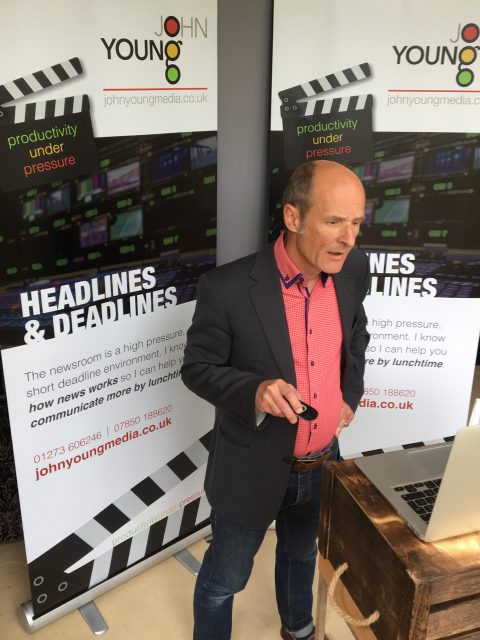Maybe I’m too old school. Maybe 31 years reporting for BBC have turned me into too much of a fusspot when it comes to professional standards on air.
But I’ve been quite taken aback at the shambles I’ve seen produced recently by companies hoping to be taken seriously as key players in our now online, “on air”, working world.
Here are three recent examples — followed by three suggestions of how you can avoid making the same mistakes. They may ensure that in this unforgiving new world of the laptop lens, your first impression isn’t your last. Because people can turn off very easily when you’re online.
PROBLEM 1: The Business Guru who slurps his coffee
I tuned into a talk given by a top Canadian business analyst guru the other day. He’d done Ted (not just TedX), he was big on the US circuit, it seems he’s done the lot. The title of his talk seemed relevant: “Agility Online”, so I thought I’d give it a go. But for me, his credibility online was undermined before he’d uttered a word.
For the four minutes before the 4pm start (11am in Toronto), the gathering audience watched as he shuffled his papers, slurped his coffee, scratched his forehead, looked slightly stressed, fiddled with his laptop in front of him (at least, I’m assuming it was his laptop), adjusted his collar …
SOLUTION: Don’t go on air until you’re ready to go on air. There’s a reason TV News bulletins start at a set time: we’re need the minutes beforehand to shuffle our papers, slurp our coffee (well, water in a news studio: no hot drinks permitted), look slightly stressed, etc etc.
It’s easy to conceal all this when presenting online by sharing a slide on your screen until you’re ready to go on air. A bit like that test-card image anyone who watched TV in the 70s will be familiar with. Though it might be better for you to use it for, say, the title of the talk, or information about the structure of your event.
PROBLEM 2: The Interactive Trainer who wasn’t Interactive
This comes from a webinar I watched recently, delivered by a hot-shot training company, promising tips on how to make online workshops more engaging. (I’m pretty sure I’m ahead of the curve on that, but complacency can lead to a downfall, so I like to keep an eye on these things.)
The trainer stressed the point I often make: that online you need to work harder to keep your audience’s attention. She urged us to use chat, use breakout rooms and polling. But she didn’t use any — “no time” she cried, as she tore into the next text-heavy slide.
SOLUTION: if you suggest it, do it. It goes back to the basics of good training: don’t simply tell people about an experience, get them to experience it for themselves. And if that sounds a bit risky — because you’re not 100% sure of how to use chat, breakout rooms and polling yourself — then consider rehearsing on a forgiving audience first: your family.
My step-father turned 86 in April: the little Zoom party I organised happened to involve a quiz (polling), a chance to catch up in smaller groups (breakout rooms) and written answers (chat). It was the equivalent of me taking the car for a spin with the L plates on, to ensure my paid for webinars aren’t a car crash themselves.

Standing up gives gravitas. And banners give your business a plug.
PROBLEM 3: Look Behind You
Many people are picking up on all this now. But there are still plenty of examples out there — in free webinars and paid for training, as well as interviewees on TV News bulletins — of people who appear not to have given a moment’s thought to, well, how they appear.
I don’t mean hair and make-up. We can all be forgiven for that these days. I mean: the distracting image over the shoulder, the plant shooting out of the top of the head, the weird camera angle that suggests the speaker is about to either pounce down the lens, or disappear altogether if you blink.
SOLUTION: if you run a business, use this as a chance to promote it. Remember those pop up banners gathering dust because you’re not popping up at any business conventions these days? Pop them up.
If you’ve not got banners, find a neutral wall for your backdrop. Dress it a little with a plant (orchids look good), but not, I suggest, with a funky psychedelic piece of artwork that will only draw your audience’s attention away from what you’re saying. And put your laptop on a pile of books to make sure you’re looking it in the eye, not down your nose.
It’s easy for me to sneer. We’re all learning fast. Broadcasting has, until now, had a touch of glamour and mystery to it: look smart on air, they’ll never see the mess in the dressing room just across the corridor from the studio.
But that era has gone.
If you run a business, you’re in the broadcasting business. We’re all on air, now.
If you’d like to experience a 45 minute workshop that uses polling, chat and breakout rooms to help you Hold the Zoom Room, I can help … find out more here …